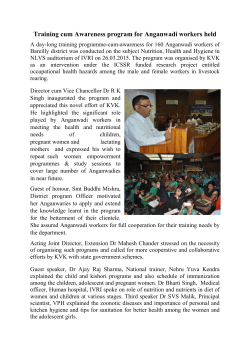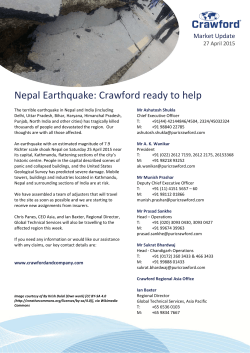
Performance Appraisal of AnganwadiWorkers
RESEARCH LETTERS TABLE I IODINE STATUS OF THE STUDY POPULATION ON THE BASIS OF UIE (WHO CRITERIA) (N=292) ACCORDING TO STUDY AREAS AND GENDER Study/Area Severe ID (<20 μg/L) Moderate ID Mild ID (20-49 μg/L) (50-99 μg/L) Adequate (100-199 μg/L) More than adequate (200-299 μg/L) Excessive Iodine (>300 μg/L) *Areas 12 (11.1%) 8 (7.4%) 12 (11.1%) 16 (14.8%) 20 (18.5%) 40 (37.0%) #Gender Shree Antu (n=108) Ranke (n=184) 18 (9.8%) 17 (9.2%) 31(16.8%) 44 (23.9%) 44 (23.9%) 30 (16.3%) Male (n=168) 16 (9.5%) 8 (4.8%) 24 (14.3%) 34 (20.2%) 40 (23.8%) 46 (27.4%) Female (n=124) 14 (11.3%) 17 (13.7%) 19 (15.3%) 26 (21.0%) 24 (19.4%) 24 (19.4%) 30 (10.3%) 25 (8.6%) 43 (14.7%) 60 (20.5%) 64 (21.9%) 70 (24.0%) Total ID = Iodine deficiency; *P=0.003; #=0.09. hilly areas and there is no sustainable improvement in median UIE. Even though the population has adequate median UIE, 33.6% school children had UIE<100 μg/L. This finding is similar to those shown by the report of Nepal Micronutrient Status Survey in 1998, which had shown 35.1% of school children iodine deficient. A previous study [6] showed that 18.5% children were iodine-deficient in hilly regions of Nepal. As iodine deficiency is the most common cause of preventable brain damage in children, it should be virtually eliminated from every part of the country [2]. Our study suggests that children living in high altitude of hilly regions at the time of study had adequate iodine nutrition. REFERENCES 1. National Survey and Impact study for Iodine Deficiency Disorders (IDD) and availability of iodized salt in Nepal. Kathmandu, Nepal: Ministry of Health and Population, Department of Health Services, Government of Nepal, Government of India and Alliance Nepal, 2007. 2. Pandav CS, Yadav K, Srivastava R, Pandav R, Karmarkar MG. Iodine deficiency disorders (IDD) control in India. Indian J Med Res. 2013;138:418-33. 3. Ohashi T, Yamaki M, Pandav CS, Karmarkar MG, Irie M. Simple microplate method for determination of urinary iodine. Clin Chem. 2000;46:529-36. 4. Zimmermann MB, Jooste PL, Pandav CS. Iodinedeficiency disorders. Lancet. 2008;372(9645):1251-62. 5. Nepal AK, Khatiwada S, Shakya PR, Gelal B, Lamsal M, Brodie D, et al. Iodine status after iodized salt supplementation in school children of eastern Nepal. Southeast Asian J Trop Med Public Health. 2013;44:1072-8. 6. Gelal B, Aryal M, Das BKL, Bhatta B, Lamsal M, Baral N. Assessment of iodine nutrition status among school age children of Nepal by urinary iodine assay. Southeast Asian J Trop Med Public Health. 2009;40:538-43. *SAROJ KHATIWADA, BASANTA GELAL, SHARAD GAUTAM, MADHAB LAMSAL AND NIRMAL BARAL *Department of Pharmacy, Central Institute of Science and Technology (CIST) College, Pokhara University, Kathmandu; and Department of Biochemistry, BP Koirala Institute of Health Sciences, Ghopa, Dharan, Nepal. khatiwadasaroj22@gmail.com this cross-sectional exploratory study to assess the performance of Anganwadi workers in selected Anganwadi centers of a North Indian city. Permission from Social Welfare Department and ethical approval from Institute Ethical Committee were obtained. Performance Appraisal of Anganwadi Workers Fourteen Anganwadi workers and 100 ICDS beneficiaries were chosen as a sample of convenience. Tools used for data collection were performance appraisal checklist to appraise the performance of Anganwadi workers, and interview schedule to assess the satisfaction level of ICDS beneficiaries. Observation and interview were the techniques used for data collection. A total of 24 observations were made from selected Anganwadi Integrated child development scheme (ICDS) was launched in 1975 in India [1]. The ICDS services, which include supplementary nutrition, preschool education, immunization, health check-ups, health education and referral services, are delivered by Anganwadi worker. In view of the increased burden on them, the performance of Anganwadi worker has been under scrutiny. We conducted INDIAN PEDIATRICS 437 VOLUME 52__MAY 15, 2015 RESEARCH LETTERS TABLE I PERFORMANCE OF ANGANWADI WORKERS DIFFERENT ACTIVITIES OF ICDS (N= 14) Activity Rapport building Area mapping Supplementary nutrition Poor - Average - TABLE II SATISFACTION LEVEL SERVICES PROVIDED (N= 100) IN Good ICDS services 14 14 - - - 13 1 Growth monitoring - 7 07 Referral services* - - - OF BY BENEFICIARIES WITH ANGANWADI WORKERS Level of satisfaction Dissatisfied Uncertain Satisfied General aspects* 5 4 91 Supplementary nutrition 7 10 83 5 2 93 26 10 64 Preschool education Immunization 01 1 12 Health education Health and nutrition education 03 4 07 Immunization 9 4 87 19 13 69 - - - Health check up Preschool education 02 7 05 Referral services - - 100 Services for adolescent girls 03 3 08 SABLA 6 - 94 Average 10 05 85 Treatment of minor illness* Services for pregnant mothers 05 8 01 Services for postnatal mothers** 04 2 - Record maintenance Home visit - - 14 10 - 04 *General aspects of services include behavior, rapport, punctuality, efficiency of Anganwadi worker. *No case reported during the study period; **only 6 Anganwadi centers were having postnatal mothers in the respective area. [2]. Another study conducted in Maharashtra showed that majority of beneficiaries were fairly satisfied with the services provided by Anganwadi workers [3]. centers. Beneficiaries were interviewed in their houses. The collected data were analyzed using SPSS 16.0. The performance of Anganwadi workers in fieldbased activities should be emphasized, and in-service education activities should be planned to improve their performance in deficient areas. Performance of the Anganwadi workers is presented in Table I. They were good in rapport building and record maintenance. All the Anganwadi workers performed poorly in area mapping, and ten of them were poor in home visits. Majority (85) of beneficiaries were satisfied with the services provided by Anganwadi workers. Satisfaction level was highest with referral services, preschool education and services for adolescents (Table II). *DAMANPREET KAUR, MANJULA THAKUR, AMARJEET SINGH AND SUSHMA KUMARI SAINI National Institute of Nursing Education (NINE), PGIMER, Chandigarh, India. *daman71288@gmail.com REFERENCES 1. National Institute of Public Cooperation and Child Development. Handbook for Anganwadi workers; 2006. Available from: http://nipccd.nic.in/syllabi/eaw.pdf. Accessed February 10, 2015. 2. National Institute of Public Cooperation and Child Development. Research on ICDS An Overview Volume 2; 2009. Available from: http://nipccd.nic.in/reports/ icdsvol2.pdf. Accessed February 11, 2015. 3. Gulabrao JA. A sociological study of Anganwadis in Sangli city of Maharashtra state 2013. Available from: http:// shodhganga.inflibnet.ac.in:8080/jspui/bitstream/10603/ 8595/6/15%20topic%207.pdf. Accessed February 10, 2015. The performance of Anganwadi workers was rated as poor only in two of the activities: home visiting and area mapping. This might be due to lack of time available with the workers as more time was spent in other activities. In Maharashtra, the maximum monthly time spent by Anganwadi workers was for preschool education (48 hours), followed by record keeping (30 hours) and home visits (29.7 hours) [2]. About half of AWWs were rated as good in growth monitoring but half of them performed average. Earlier study from Punjab also showed that Anganwadi workers’ performance was poor in weighing INDIAN PEDIATRICS 438 VOLUME 52__MAY 15, 2015
© Copyright 2025










